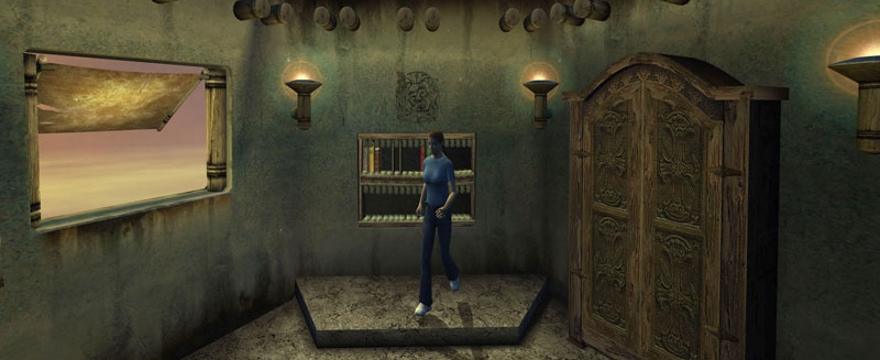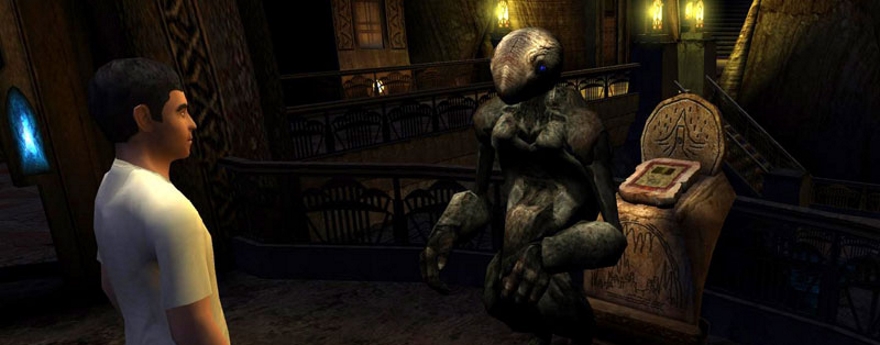
The impact of Myst in 1993 was akin to an atomic bomb going off in the PC gaming world. The leap forward in graphical fidelity (aided by the large storage capacity of a CD-ROM and all of the full-motion video and gorgeous images tucked into it) captured gamers’ imaginations and made this adventure title the best-selling PC game of all time, at least for several years. Brothers Robyn and Rand Miller’s story about a stranger who had to solve puzzles through a good-looking (if deserted) landscape was devilishly difficult, yet that challenge kept players coming back for months and even years.
The Myst franchise surged forward at that point, with several sequels, remakes, and ports selling like hotcakes through the final game’s release in 2005. Yet something interesting happened along the way when an offshoot of the series — Uru: Ages Beyond Myst — evolved into an MMO. With a focus on multiplayer exploration and puzzle-solving instead of non-stop combat, it may be one of the very few MMOs out there that eschews fighting for brainpower.
It’s an oddity, no doubt, and despite it being an incredibly niche title, it has fascinated me enough to pull me into a research rabbit hole. So let’s take a look at Myst Online: Uru Live!

Scouting the Uru trail
The path along the Uru trail is more tangled than one would imagine, so we’ll try to make this as simple as possible. In 1997, Cyan Worlds began working on a multiplayer version of Myst that would later become known as Uru: Ages Beyond Myst (or Uru Prime, as fans called it).
The idea was to create an adventure game that kept on going, with monthly updates and a connected online community. The creators denied that it was a proper MMO, since it lacked levels, inventory, and combat. It took five years to make, and even then the studio had to strip out the multiplayer component at the behest of publisher Ubisoft just to get it out of the door.
Uru was a departure for the series, delivering a customizable on-screen avatar (instead of the first-person view of the previous games) and placing players in a modern setting. Players had to go around uncovering secrets of the ancient D’ni civilization while restoring power to other Ages. The single-player game was treated to two expansions: To D’ni and The Path of the Shell. To D’ni was actually much of the episodic multiplayer content for the online game that was reworked as a single-player experience.

An on again, off again online relationship
Here’s where it starts to get tricky. Cyan finally, if briefly, turned on the multiplayer components in 2004, calling this portion of the game Uru Live. It was a short-lived experiment that ended in February of that year, although players were quick to start up unofficial servers to host the online game.
To put a stop to this, Cyan released a new online version of the game, Until Uru (which was basically Uru Live) in 2006. It was a stop-gap product, sectioning off players onto separate servers and lacking ongoing development and additional content. This time the game got shut down due to the title being transferred to a new publisher, GameTap, which wanted to do the online thing its own way.
GameTap started up a beta for Myst Online: Uru Live in 2006 and officially launched the title in February 2007. The game struggled to generate enough subscription revenue, and it wasn’t online but a year before the publisher shut it down.
A GameTap representative commented on the decision: “There weren’t as many people attracted to the game as we’d initially thought. We’re very happy with the content produced by Cyan. We think the product was pretty good. But either we were the wrong delivery vehicle for it or we didn’t hit on the exact formula for delivering this kind of content.”
Creator Rand Miller gave his own take on why Myst Online had such a hard time gaining traction, saying, “It’s frankly cheaper to build a treadmill than a national park. We were building a national park.”
The players and Cyan weren’t willing to let Uru die, however, and the studio eventually reacquired the rights to the game in 2008. In February 2010, Cyan started up Myst Online once more, although players had to begin their journeys anew. There was big talk about a Myst Online: Restoration Experiment (MORE) to crowdsource improvements for the game, but Cyan eventually didn’t have enough resources to pull it off.
Instead, the studio made the game free for all to play with optional donations toward the operating costs. Cyan also made it open source so that players could experiment with their own servers, and allowed the team to take the best innovations and incorporate them back into the game.

An online world unlike any other
The one thing that both Cyan and long-time players want newcomers to realize is just how different this title is from traditional MMOs. “Instead of repetitive kill/take/buy gameplay of other MMOGs, the very essence of Myst Online is to explore vast, fantastic worlds; savoring and uncovering new areas and new information at every turn,” the official website states.
So what is the game like? In Myst Online, players begin in New Mexico, where they are given a home instances (called a “Relto”) and then encouraged to venture into caverns underground. In an interesting twist, gamers don’t start out with their HUD (a “Ki”) but have to earn it early on.
The goal of the game is to rediscover, restore, and rebuild the remnants of the ancient civilization known as D’ni. This can only be done by hopping around through several ages, each with its own story and set of fiendish puzzles. Each age has seven Journey tapestries hidden in it, and once these are uncovered and acquired, the player completes that world and gets an item to take back to his or her Relto. Any acquired book pages also transform into decorations for the Relto, adding customization to one’s home instance.
While the puzzles and exploration can be done solo, progress is made much easier by joining up with others and using multiple bodies (and brains) to complete them. When players aren’t puzzle-solving in the game, there are plenty of optional fun activities in the main city, including games like hide-and-go-seek, find-the-marker quests, and rock, paper, scissors.
I found it was fascinating that Myst Online uses voice chat, not merely for an internal party but to anyone within the range of your character’s “voice.” Now that I think about it, it’s a shame more games don’t experiment with this!
One player gave a great description of what made the game so special. “[Myst Online] is a multiplayer online game unlike any other,” the player wrote. “You don’t level up, learn skills or trades, buy equipment, or fight. So, what is there? Let’s start with a gorgeous, imaginative virtual universe where you can indulge your love of discovery. Then add in thought-provoking puzzles. Next throw in a marvelous but decaying city where you can run, dance, play, and socialize to your heart’s content. Sound interesting? Uru provides all this and more.”
Myst Online was, and still is, an abnormality among a community that cries for innovation but often doesn’t have the patience to embrace it. The focus on puzzle-solving, community interaction, and lore-building put this into a category of its own until The Secret World released.
It does my heart good to see that Myst Online is still alive and kicking, even if it will never be the topic on most gamers’ lips. And since you’re reading this, why not listen to some of the odd and atmospheric music of the game?
 Believe it or not, MMOs did exist prior to World of Warcraft! Every two weeks, The Game Archaeologist looks back at classic online games and their history to learn a thing or two about where the industry came from… and where it might be heading.
Believe it or not, MMOs did exist prior to World of Warcraft! Every two weeks, The Game Archaeologist looks back at classic online games and their history to learn a thing or two about where the industry came from… and where it might be heading.














